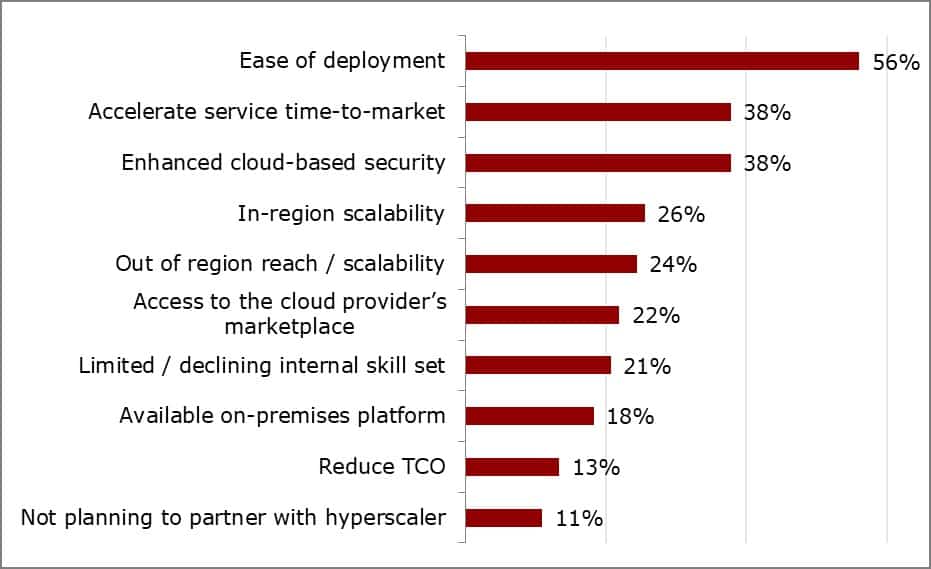For mobile operators, the edge is a new frontier. And like geographic frontiers such as the American Wild West, the mobile edge is full of both promise and peril. Going at it alone is risky.
That’s why 89% of communications service providers (CSPs) that have launched multi-access edge computing (MEC) solutions, or plan to do so by the end of 2023, and are partnering with hyperscalers, according to a market engagement exerciseof 82 communication service providers. There’s a variety of reasons why, but surprisingly, saving money is not one of them. Only 13% of CSPs respondents say they partner with a hyperscaler to reduce total cost of ownership (TCO).
As Figure 1 shows, ease of deployment is the top reason by a wide margin. “It is even more dominant with the largest carriers that earn $5 billion+ in annual revenue - with 67% selecting it compared to 49% for smaller carriers,” says Heavy Reading Principal Analyst, Jennifer Clark.
 Figure 1: The reasons CSPs partner with hyperscalers (Q: Why do you plan to partner with a hyperscaler to deliver your edge computing? Select up to three.)
Figure 1: The reasons CSPs partner with hyperscalers (Q: Why do you plan to partner with a hyperscaler to deliver your edge computing? Select up to three.)
Besides enabling mobile operators to snap up enterprise customers before slower rivals, speedy rollouts also mean faster time to revenue. That’s a major plus because edge compute, connectivity and related private 5G campus networks are key for driving a return on their enormous 5G investments.
What hyperscalers bring to the partnership
While operators were building out 5G networks, hyperscalers were equally busy developing MEC solutions to leverage them, such as dedicated edge products and software stacks that can be embedded into 5G infrastructure and Internet of Things (IoT) devices. Examples include Amazon Web Services’ Wavelength, Google Cloud’s Anthos for Telecom, and Microsoft’s Azure Edge Zones.
Private 5G for everyone
Why? Hyperscalers recognized early on that 5G has unique capabilities that enables applications and use cases that aren’t practical or, in many cases, even possible with 4G LTE and Wi-Fi. Although some utility companies, railroads, and other enterprises have owned 3G and 4G networks for decades, 5G is making the private network campus viable for a much wider range of organizations, including warehouse, logistics and transport providers, port authorities, and manufacturers.
Many private 5G network applications are a natural fit for edge computing. For example, a factory might use its private 5G network to backhaul real-time data from its industrial robots, autonomous material handlers, and other production equipment to an edge cloud for rapid analysis. Continuous real-time monitoring and analytics helps quickly identify emerging production problems that could affect the factory’s ability to meet just-in-time production schedules for the upstream plants that it supplies. MEC also saves money because that all data isn’t constantly being sent to a distant cloud, such as to the corporate headquarters in another part of the country or world.
When it launched Azure Edge Zones in 2020, Microsoft did a great job of summarizing how the ecosystem and end users all benefit when hyperscalers partner with operators, including enterprises that have private 5G networks:
“Carriers, operators, and networking providers can build 5G-optimized services and applications for their partners and customers with Azure Edge Zones, taking advantage of Azure compute, storage, networking, and AI capabilities. For organizations that want an on-premises, private mobile solution, partners and carriers can deploy, manage, and build offers with Azure Private Edge Zones. Customers need help understanding the complexities of the cellular spectrum, access points, and overall management. Carrier partners can help such enterprises manage these scenarios including manufacturing, robotics, and retail.”
Cloud hyperscalers give operators a way to scale and upskill their workforce and virtualize their networks on cloud infrastructure, such as with Open RAN. However, CSPs still have to carefully consider why and when to partner. Service providers need to ensure they drive revenue from new 5G services, but also add value with services such as real-time performance KPI reporting and end-to-end security monitoring that enterprises care about.
Service assurance is key
Smart cities, manufacturers, logistics providers, health care providers, and first responders will have many mission-critical applications relying on hyperscale 5G MEC services. Those enterprises will use service-level agreements (SLA) to ensure that those services consistently deliver the availability, bandwidth, scalability, latency and other attributes that their applications require.
As a result, operators and their hyperscaler partners will need to work closely to ensure that everything from network connectivity to compute infrastructure meets customer SLAs and business outcomes. This will require tools capable of providing real-time reporting about application and network performance, for example. That’s a tall order, but operators and hyperscalers that are up to the task will be uniquely positioned to capitalize on the burgeoning 5G MEC market opportunity.
“Assuring service performance at the edge is not easy,” Clark says. “Controlling and managing edge performance, gaining insight from key performance indicators (KPIs), and correlating virtual and physical layers for automation all have to be considered and built in at the service design phase, not as an afterthought - just like security must be an upfront criterion.”






















